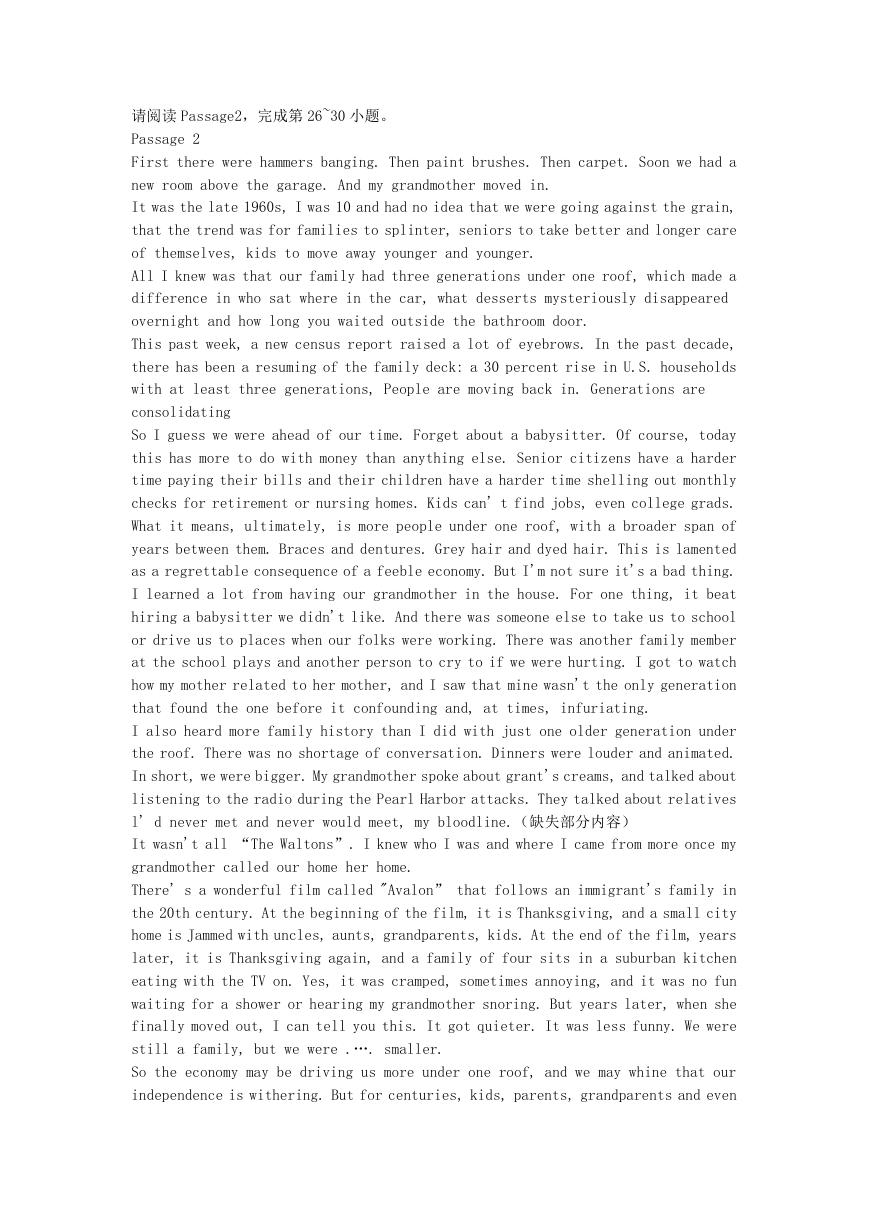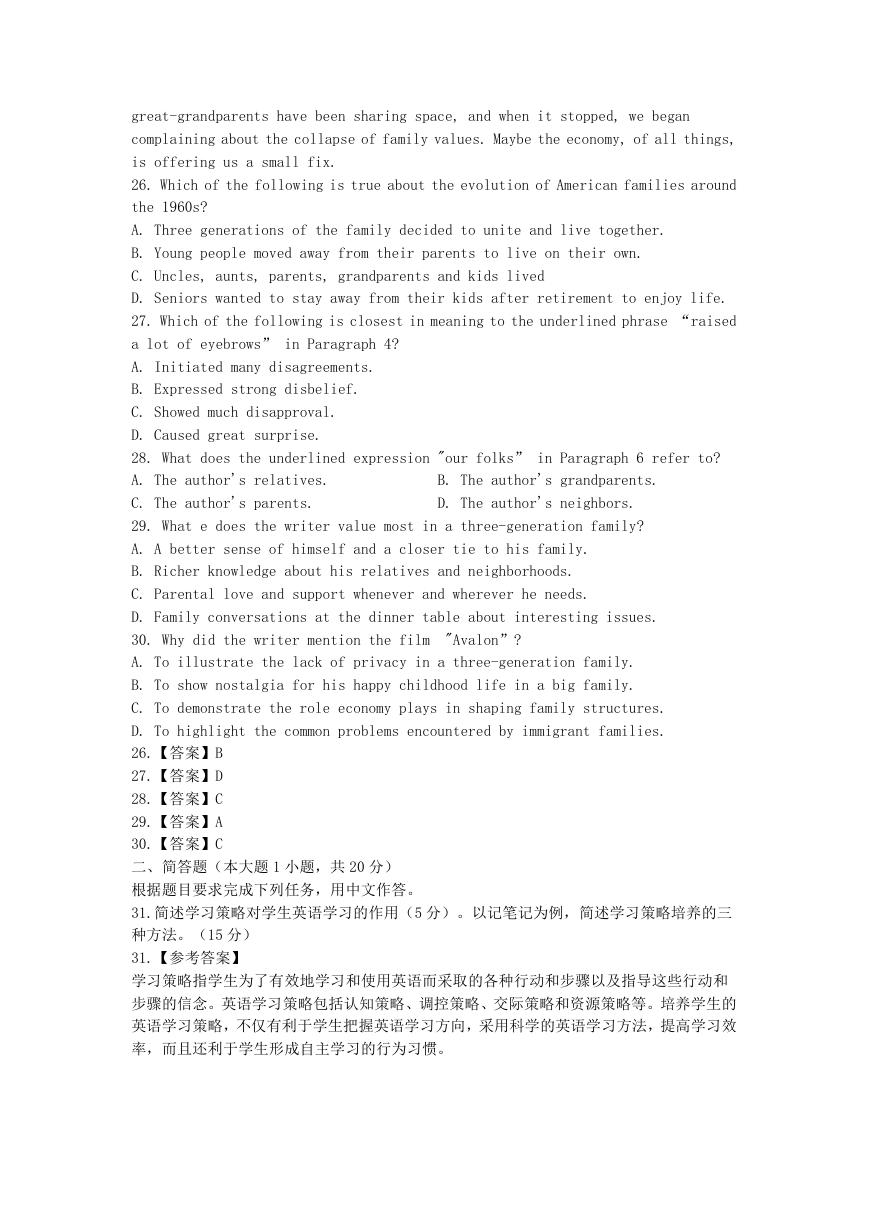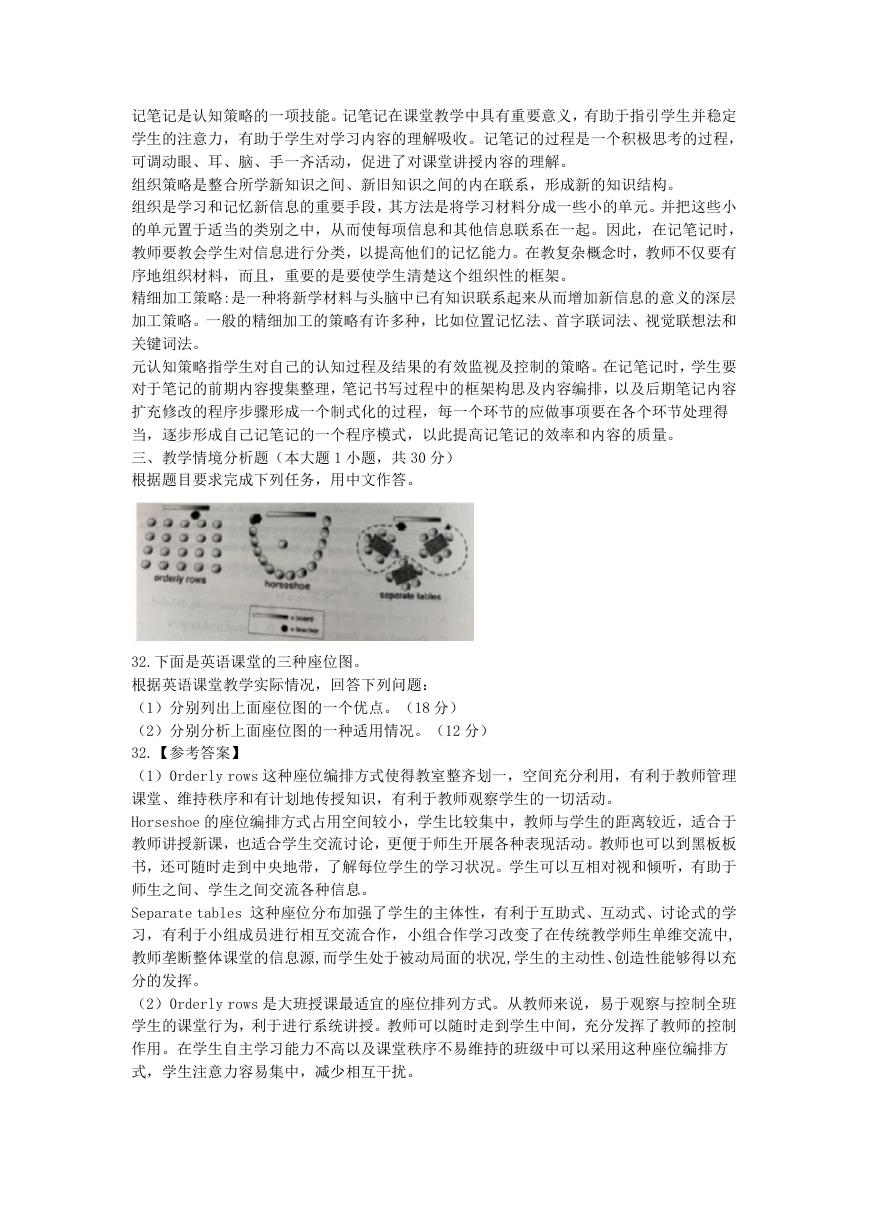2020 下半年湖北教师资格初中英语学科知识与教学能力真
题及答案
B. Caterpillar
D. Accompany
B. paled
D. blurred
B./pades'triən/
D./pa'destriən/
注意事项:
1.考试时间为 120 分钟,满分为 150 分。
2.请按规定在答题卡上填涂、作答。在试卷上作答无效,不予评分。
一、单项选择题(本大题共 30 小题,每小题 2 分,共 60 分)
1. Which of the following shows the correct stress of the word "pedestrian" ?
A./'padestriən/
C./padestri'ən/
【答案】D
2. Which of the following words has a different stress pattern?
A. Facility
C. Community
【答案】B
3. Because of the strong sun the new drawing-room curtains have
to grey.
A. fade
C. fainted
【答案】A
4. Which of the following pairs of words are synonyms?
A. Red-color
C. Petrol-gasoline
【答案】C
5. We don't know what experiment those researchers would
hypothesis.
A. apply
C. deliver
【答案】B
6. Tom said he would go to Hong Kong for winter vacation and he
A. did
C. does
【答案】A
7. It is forbidden
A. to driving
C. being driven
【答案】B
8. In the sentence "It's no use crying over the spilt milk", the italicized part
is
A. an object
C. a subject
【答案】C
B. to drive
D. to be driven
B. an adverbial
D. a complement
B. Tall-short
D. Father-father
B. carry
D. perform
B. had
D. will
faster than 60 mph on this highway.
from dark blue
on females to test this
go.
.
�
B. Competence
D. Acquisition
B. An observer
D. A prompter
B. Phatic
D. Performative
9. Which of the following describes the function of the sentence “It is a nice day,
isn't it”?
A. Informative
C. Directive
【答案】B
10. Which of the following describes the process in which one's language ability
is developed in natural and everyday situation?
A. Performance
C. Learning
【答案】D
11. What role does he/she play when a teacher explains the purpose of a task, the
steps to do it and its time limit?
A. An organizer.
C. An evaluator
【答案】A
12. What does he/she intend to do when a teacher writes the following sentences “She
gets up early. She wears a uniform. She works very hard.” on the blackboard at the
presentation stage?
A. Practice sentence patterns using model sentences.
B. Check if students can pronounce the sentences.
C. Monitor whether students can accurately express their ideas.
D. Draw students' attention to the form of a new language item.
【答案】D
13. What skill does he/she use when a student uses language knowledge and contextual
clues to figure out the meaning of a new word?
A. Contrasting.
C. Deducing
【答案】C
14. Supplementing, deleting, simplifying and reordering are often used in
A. adapting teaching materials
B. delivering teaching materials
C. evaluating teaching materials
D. presenting teaching materials
【答案】A
15. Which of the following is least recommended at the lead-in stage in a reading
class?
A. Activating students' schema of the topic.
B. Giving advice on how to use reading strategies.
C. Sharing background information about the text.
D. Correcting language mistakes students have made.
【答案】D
16. Which of the following best describes the phenomenon that learners apply the
skills acquired in one field to another?
A. Transfer
B. Summarizing
D. Predicting
.
B. Deduction
�
D. Induction
B. Story-telling.
D. Translation.
B. process
D. format
C. Contextualization
【答案】A
17. If the focus is placed on
students are supposed to go through the stages
of drafting, receiving feedback, and revising before submitting the final version
of their writing.
A. Product
C. genre
【答案】B
18. What would he/she do in a reading class if a teacher wants to develop students'
inferential comprehension?
A. Ask them to retell the story.
B. Ask them to underline difficult sentences.
C. Ask them to read the text sentence by sentence.
D. Ask them to read the text for implied meaning.
【答案】D
19. Which of the following activities can be used if the focus is on developing
students' oral fluency in English?
A. Blank-filling.
C. Transformation.
【答案】B
20. What is the focus when a teacher says to the class" Rewrite each of the following
sentences using the passive voice.
A. Skill
C. Structure
【答案】C
请阅读 Passage1, 完成第 21~25 小题。
Passage 1
In a traditional classroom, much, if not most, of class time is spent with the teacher
presenting content -telling, showing, explaining and lecturing. Whether it's a
first-grade teacher reading to students, a high school government teacher lecturing
on the Articles of Confederation, or a math teacher demonstrating how to solve an
equation, class time is when the teacher delivers information and the students
receive it .
Ideally, lessons involve a mixture of delivery and discussion, supplemented by
activities that engage students to support their comprehension. But in reality, just
getting the content across can take most of the class period, especially when lessons
are interrupted by student questions, discipline problems, and distractions like
fire drills, assemblies, and other disruptions.
There are lots of good reasons for this model and its durability in education. It
is an efficient way to assure that all students have access to the same course content,
and it provides a way for teachers to transmit their expertise in a subject, and
enthusiasm for it, to their students. Most teachers love being the "sage on the stage",
and many are very good at it.
B. Meaning
D. Function
�
and inquiry activities.
B. Liberal
D. Authoritative
their excitement and comprehension. In today's
Nevertheless, many teachers also feel frustrated by the limitations of this model,
especially when lecture and presentation take up the lion' s share of the class period,
leaving little time for the good stuff of teaching 一 getting into students', helping
them make meaning out of information, drawing out their evolving understanding,
encouraging and sparkling
environment of high-stakes testing, with multiple standards—and now with the Common
Core, new standards—there never seems to be enough time for all the things teachers
wish they could do with their students: project-based activities, individual or
group learning challenges, Deep discussions
So it' s not surprising that, when teachers are asked what they believe is the
greatest value of flipping instruction, the answer is almost always, “It gives me
more time to work directly with students during class.” Teachers at Michigan's
Clintondale High School claim that, since they have flipped their classrooms, the
amount of time they spend with students has increased by a factor of four. That is
substantial gain—and it makes a real difference in students believing that the
teacher is there for them when help is needed.
21. According to the passage, what differentiates a flipped classroom from a
traditional one?
A. The amount of time that teachers spend with individual students.
B. The amount of knowledge that teachers impart to students.
C. The content of the teaching materials used by teachers.
D. The variety of activities organized by teachers.
22. According to the passage, which of the following features typically
characterizes a traditional classroom?
A. Inquiry
C. Exemplification
23. Which of the following best explains the underlined expression "sage on the
stage?" in Paragraph 3?
A. Demanding
C. Imaginative
24. According to Paragraph 4, what should have been incorporated in traditional
classrooms?
A. Preparing students for high-stakes tests.
B. Developing students' analytical thinking skills.
C. Assisting students to attain the Common Core standards.
D. Enhancing students' ability to cope with learning pressures.
25. Which of the following reflects the author's view on a flipped classroom?
A. Radical
C. Supportive
21.【答案】A
22.【答案】B
23.【答案】D
24.【答案】B
25.【答案】C
B. Opposed
D. Paradoxical
B. Delivery
D. Discussion
�
请阅读 Passage2,完成第 26~30 小题。
Passage 2
First there were hammers banging. Then paint brushes. Then carpet. Soon we had a
new room above the garage. And my grandmother moved in.
It was the late 1960s, I was 10 and had no idea that we were going against the grain,
that the trend was for families to splinter, seniors to take better and longer care
of themselves, kids to move away younger and younger.
All I knew was that our family had three generations under one roof, which made a
difference in who sat where in the car, what desserts mysteriously disappeared
overnight and how long you waited outside the bathroom door.
This past week, a new census report raised a lot of eyebrows. In the past decade,
there has been a resuming of the family deck: a 30 percent rise in U.S. households
with at least three generations, People are moving back in. Generations are
consolidating
So I guess we were ahead of our time. Forget about a babysitter. Of course, today
this has more to do with money than anything else. Senior citizens have a harder
time paying their bills and their children have a harder time shelling out monthly
checks for retirement or nursing homes. Kids can' t find jobs, even college grads.
What it means, ultimately, is more people under one roof, with a broader span of
years between them. Braces and dentures. Grey hair and dyed hair. This is lamented
as a regrettable consequence of a feeble economy. But I'm not sure it's a bad thing.
I learned a lot from having our grandmother in the house. For one thing, it beat
hiring a babysitter we didn't like. And there was someone else to take us to school
or drive us to places when our folks were working. There was another family member
at the school plays and another person to cry to if we were hurting. I got to watch
how my mother related to her mother, and I saw that mine wasn't the only generation
that found the one before it confounding and, at times, infuriating.
I also heard more family history than I did with just one older generation under
the roof. There was no shortage of conversation. Dinners were louder and animated.
In short, we were bigger. My grandmother spoke about grant's creams, and talked about
listening to the radio during the Pearl Harbor attacks. They talked about relatives
l' d never met and never would meet, my bloodline.(缺失部分内容)
It wasn't all “The Waltons”. I knew who I was and where I came from more once my
grandmother called our home her home.
There' s a wonderful film called "Avalon” that follows an immigrant's family in
the 20th century. At the beginning of the film, it is Thanksgiving, and a small city
home is Jammed with uncles, aunts, grandparents, kids. At the end of the film, years
later, it is Thanksgiving again, and a family of four sits in a suburban kitchen
eating with the TV on. Yes, it was cramped, sometimes annoying, and it was no fun
waiting for a shower or hearing my grandmother snoring. But years later, when she
finally moved out, I can tell you this. It got quieter. It was less funny. We were
still a family, but we were .…. smaller.
So the economy may be driving us more under one roof, and we may whine that our
independence is withering. But for centuries, kids, parents, grandparents and even
�
B. The author's grandparents.
D. The author's neighbors.
great-grandparents have been sharing space, and when it stopped, we began
complaining about the collapse of family values. Maybe the economy, of all things,
is offering us a small fix.
26. Which of the following is true about the evolution of American families around
the 1960s?
A. Three generations of the family decided to unite and live together.
B. Young people moved away from their parents to live on their own.
C. Uncles, aunts, parents, grandparents and kids lived
D. Seniors wanted to stay away from their kids after retirement to enjoy life.
27. Which of the following is closest in meaning to the underlined phrase “raised
a lot of eyebrows” in Paragraph 4?
A. Initiated many disagreements.
B. Expressed strong disbelief.
C. Showed much disapproval.
D. Caused great surprise.
28. What does the underlined expression "our folks” in Paragraph 6 refer to?
A. The author's relatives.
C. The author's parents.
29. What e does the writer value most in a three-generation family?
A. A better sense of himself and a closer tie to his family.
B. Richer knowledge about his relatives and neighborhoods.
C. Parental love and support whenever and wherever he needs.
D. Family conversations at the dinner table about interesting issues.
30. Why did the writer mention the film
A. To illustrate the lack of privacy in a three-generation family.
B. To show nostalgia for his happy childhood life in a big family.
C. To demonstrate the role economy plays in shaping family structures.
D. To highlight the common problems encountered by immigrant families.
26.【答案】B
27.【答案】D
28.【答案】C
29.【答案】A
30.【答案】C
二、简答题(本大题 1 小题,共 20 分)
根据题目要求完成下列任务,用中文作答。
31.简述学习策略对学生英语学习的作用(5 分)。以记笔记为例,简述学习策略培养的三
种方法。(15 分)
31.【参考答案】
学习策略指学生为了有效地学习和使用英语而采取的各种行动和步骤以及指导这些行动和
步骤的信念。英语学习策略包括认知策略、调控策略、交际策略和资源策略等。培养学生的
英语学习策略,不仅有利于学生把握英语学习方向,采用科学的英语学习方法,提高学习效
率,而且还利于学生形成自主学习的行为习惯。
"Avalon”?
�
记笔记是认知策略的一项技能。记笔记在课堂教学中具有重要意义,有助于指引学生并稳定
学生的注意力,有助于学生对学习内容的理解吸收。记笔记的过程是一个积极思考的过程,
可调动眼、耳、脑、手一齐活动,促进了对课堂讲授内容的理解。
组织策略是整合所学新知识之间、新旧知识之间的内在联系,形成新的知识结构。
组织是学习和记忆新信息的重要手段,其方法是将学习材料分成一些小的单元。并把这些小
的单元置于适当的类别之中,从而使每项信息和其他信息联系在一起。因此,在记笔记时,
教师要教会学生对信息进行分类,以提高他们的记忆能力。在教复杂概念时,教师不仅要有
序地组织材料,而且,重要的是要使学生清楚这个组织性的框架。
精细加工策略:是一种将新学材料与头脑中已有知识联系起来从而增加新信息的意义的深层
加工策略。一般的精细加工的策略有许多种,比如位置记忆法、首字联词法、视觉联想法和
关键词法。
元认知策略指学生对自己的认知过程及结果的有效监视及控制的策略。在记笔记时,学生要
对于笔记的前期内容搜集整理,笔记书写过程中的框架构思及内容编排,以及后期笔记内容
扩充修改的程序步骤形成一个制式化的过程,每一个环节的应做事项要在各个环节处理得
当,逐步形成自己记笔记的一个程序模式,以此提高记笔记的效率和内容的质量。
三、教学情境分析题(本大题 1 小题,共 30 分)
根据题目要求完成下列任务,用中文作答。
32.下面是英语课堂的三种座位图。
根据英语课堂教学实际情况,回答下列问题:
(1)分别列出上面座位图的一个优点。(18 分)
(2)分别分析上面座位图的一种适用情况。(12 分)
32.【参考答案】
(1)0rderly rows 这种座位编排方式使得教室整齐划一,空间充分利用,有利于教师管理
课堂、维持秩序和有计划地传授知识,有利于教师观察学生的一切活动。
Horseshoe 的座位编排方式占用空间较小,学生比较集中,教师与学生的距离较近,适合于
教师讲授新课,也适合学生交流讨论,更便于师生开展各种表现活动。教师也可以到黑板板
书,还可随时走到中央地带,了解每位学生的学习状况。学生可以互相对视和倾听,有助于
师生之间、学生之间交流各种信息。
Separate tables 这种座位分布加强了学生的主体性,有利于互助式、互动式、讨论式的学
习,有利于小组成员进行相互交流合作,小组合作学习改变了在传统教学师生单维交流中,
教师垄断整体课堂的信息源,而学生处于被动局面的状况,学生的主动性、创造性能够得以充
分的发挥。
(2)0rderly rows 是大班授课最适宜的座位排列方式。从教师来说,易于观察与控制全班
学生的课堂行为,利于进行系统讲授。教师可以随时走到学生中间,充分发挥了教师的控制
作用。在学生自主学习能力不高以及课堂秩序不易维持的班级中可以采用这种座位编排方
式,学生注意力容易集中,减少相互干扰。
�
Horseshoe 比较适合低学段的小班教学,对于低学段的英语教学中所需的各种角色扮演、游
戏活动、歌舞表演都可以非常方便地在中央地带进行。并且根据需要,可以迅速地将座位调
整成圆形、矩形(三条边)或双弧型等。学生在这种 U 型结构中可以互相对视和倾听,方便
学生之间的信息交流,教师也能很迅速地看到每个学生的反应。
Separate tables 适用于较高学段的英语教学,学生需要有较高的学习自主性和积极性,因
为在这种自由的学习空间中,教师对学生的监控很难到位,所以对于学生自身的要求较高。
在教学重点为培养学生学习能力和学习策略时可以采用此类编排方式,以培养他们的合作精
神,沟通能力和解决实际问题的能力。
四、教学设计题(本大题 1 小题,共 40 分)
根据提供的信息和语言素材设计教学方案,用英文作答。
33.设计任务:请阅读下面学生信息和语言素材,设计 20 分钟的阅读教学方案。
教案没有固定格式,但须包含下列要点
teaching objectives
teaching contents
key and difficult points
major steps and time allocation
activities and justification
教学时间:20 分钟
学生概况:某城镇普通中学八年级(初中二年级)学生,班级人数 40 人,多数学生已经达
到《义务教育英语课程标准(2011 年版)》三级水平。学生课堂参与积极性一般。
语言素材:
Summarizing
While reading, make notes or underline the main ideas in the text. After reading,
write a short summary in your own words. This can help you better understand the
text;
A Country Music Song Changed Her Life Forever
When Sarah was a teenager, she used to fight over almost everything with her family.
But five years ago, while she was study abroad in England, she heard a song full
of feelings about returning home on the radio. It made Sarah think about her family
and friends back in the US. She came to realize how much she actually missed all
of them. Ever since then, she has been a fan of American country music.
Country is a traditional kind of music from the southern states of America. Nashville,
Tennessee is the home of country music. Many songs these days are just about modern
life in the US, such as the importance of money and success, but not about belonging
to a group. However, country music brings us back to the “good old days” when people
were kind to each other and trusted one another. It reminds us that the best things
in life are free - laughter, friends, family, and the beauty of nature and the
countryside.
Sarah hasn't been to Nashville yet, but it is her dream to go there one day. She
has already read a lot about the place and done some research on it. She knows that
there is a Country Music Hall of Fame Museum in Nashville. There are also always
a lot of great country music concerts with famous musicians and singers; like Garth
brooks. Sarah has already listened to most of his songs. “Garth is one of the most
�
















 2023年江西萍乡中考道德与法治真题及答案.doc
2023年江西萍乡中考道德与法治真题及答案.doc 2012年重庆南川中考生物真题及答案.doc
2012年重庆南川中考生物真题及答案.doc 2013年江西师范大学地理学综合及文艺理论基础考研真题.doc
2013年江西师范大学地理学综合及文艺理论基础考研真题.doc 2020年四川甘孜小升初语文真题及答案I卷.doc
2020年四川甘孜小升初语文真题及答案I卷.doc 2020年注册岩土工程师专业基础考试真题及答案.doc
2020年注册岩土工程师专业基础考试真题及答案.doc 2023-2024学年福建省厦门市九年级上学期数学月考试题及答案.doc
2023-2024学年福建省厦门市九年级上学期数学月考试题及答案.doc 2021-2022学年辽宁省沈阳市大东区九年级上学期语文期末试题及答案.doc
2021-2022学年辽宁省沈阳市大东区九年级上学期语文期末试题及答案.doc 2022-2023学年北京东城区初三第一学期物理期末试卷及答案.doc
2022-2023学年北京东城区初三第一学期物理期末试卷及答案.doc 2018上半年江西教师资格初中地理学科知识与教学能力真题及答案.doc
2018上半年江西教师资格初中地理学科知识与教学能力真题及答案.doc 2012年河北国家公务员申论考试真题及答案-省级.doc
2012年河北国家公务员申论考试真题及答案-省级.doc 2020-2021学年江苏省扬州市江都区邵樊片九年级上学期数学第一次质量检测试题及答案.doc
2020-2021学年江苏省扬州市江都区邵樊片九年级上学期数学第一次质量检测试题及答案.doc 2022下半年黑龙江教师资格证中学综合素质真题及答案.doc
2022下半年黑龙江教师资格证中学综合素质真题及答案.doc